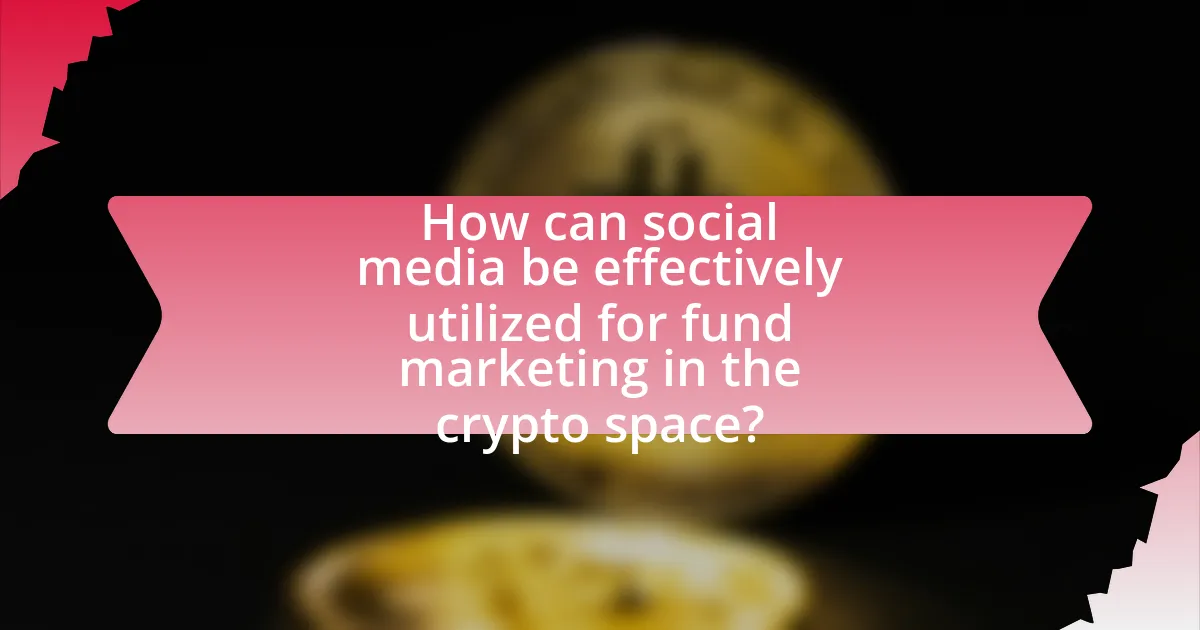The article focuses on the effective utilization of social media for fund marketing in the cryptocurrency sector. It outlines strategies such as targeted advertising, community engagement, and influencer partnerships, emphasizing the importance of platforms like Twitter, Telegram, Discord, and Reddit for reaching potential investors. Key features of these platforms, including real-time updates and community-driven discussions, are discussed, along with the advantages of social media over traditional marketing methods. The article also addresses challenges such as regulatory compliance and misinformation, while providing best practices for maintaining transparency and authenticity in marketing efforts.

How can social media be effectively utilized for fund marketing in the crypto space?
Social media can be effectively utilized for fund marketing in the crypto space by leveraging targeted advertising, community engagement, and influencer partnerships. Targeted advertising on platforms like Facebook and Twitter allows crypto projects to reach specific demographics interested in blockchain technology, increasing visibility and attracting potential investors. Community engagement through platforms such as Discord and Telegram fosters a sense of belonging and trust, encouraging users to participate in discussions and share information about the fund. Additionally, collaborating with influencers who have established credibility in the crypto space can amplify marketing efforts, as their endorsements can significantly sway potential investors. According to a report by CoinMarketCap, 70% of crypto investors rely on social media for information, highlighting the importance of these strategies in reaching and engaging the target audience effectively.
What are the key social media platforms for crypto fund marketing?
The key social media platforms for crypto fund marketing are Twitter, Telegram, Discord, and Reddit. Twitter is widely used for real-time updates and engagement with the crypto community, boasting over 300 million active users, making it a vital platform for announcements and discussions. Telegram serves as a popular messaging app for crypto groups, allowing for direct communication and community building, with over 500 million active users. Discord is increasingly favored for its community-oriented features, enabling fund managers to create dedicated servers for discussions and support, appealing to the gaming and tech-savvy audience. Reddit hosts numerous crypto-related subreddits, providing a space for in-depth discussions and community feedback, with over 50 million daily active users. These platforms collectively facilitate effective outreach and engagement in the crypto space.
How does each platform cater to the crypto audience?
Each platform caters to the crypto audience by providing tailored features and content that resonate with their interests and needs. For instance, Twitter serves as a real-time news source and community hub, allowing users to follow industry leaders and engage in discussions, which is crucial for staying updated on market trends. Reddit offers specialized subreddits where users can share insights, ask questions, and participate in community-driven discussions, fostering a sense of belonging among crypto enthusiasts. Telegram provides secure channels for direct communication and group discussions, enabling users to receive timely updates and engage with project teams. Instagram utilizes visual content to showcase projects and lifestyle aspects of crypto, appealing to a younger demographic. Each platform’s unique functionalities enhance user engagement and facilitate information exchange within the crypto community.
What unique features do these platforms offer for fund marketing?
Platforms for fund marketing in the crypto space offer unique features such as targeted advertising, community engagement tools, and analytics dashboards. Targeted advertising allows fund managers to reach specific demographics interested in cryptocurrency investments, enhancing the effectiveness of marketing campaigns. Community engagement tools, like forums and social media integration, facilitate direct interaction with potential investors, fostering trust and transparency. Analytics dashboards provide real-time insights into campaign performance, enabling fund marketers to adjust strategies based on data-driven results. These features collectively enhance the ability to attract and retain investors in a competitive market.
Why is social media important for marketing in the crypto space?
Social media is crucial for marketing in the crypto space because it enables rapid dissemination of information and fosters community engagement. The decentralized nature of cryptocurrencies aligns well with social media platforms, allowing projects to build trust and transparency through direct communication with potential investors. According to a report by Statista, 54% of cryptocurrency investors use social media to gather information about projects, highlighting its role in influencing investment decisions. Additionally, platforms like Twitter and Telegram serve as primary channels for updates, discussions, and announcements, making them essential for real-time marketing strategies in the fast-paced crypto environment.
What advantages does social media provide over traditional marketing methods?
Social media offers several advantages over traditional marketing methods, primarily through enhanced reach, engagement, and cost-effectiveness. Unlike traditional marketing, which often relies on static advertisements in print or broadcast media, social media platforms enable real-time interaction and feedback from audiences, fostering a two-way communication channel. For instance, a study by HubSpot indicates that social media marketing can generate up to 54% more leads than traditional methods, highlighting its effectiveness in audience engagement. Additionally, social media campaigns typically require lower budgets compared to traditional advertising, allowing for more flexible and targeted marketing strategies. This cost efficiency is particularly beneficial for startups and organizations in the crypto space, where budget constraints are common.
How does social media influence investor behavior in the crypto market?
Social media significantly influences investor behavior in the crypto market by shaping perceptions, driving trends, and facilitating information dissemination. Platforms like Twitter and Reddit serve as primary channels for real-time updates and discussions, which can lead to rapid price fluctuations based on sentiment and hype. For instance, a study by the University of Technology Sydney found that social media sentiment correlates with Bitcoin price movements, indicating that positive or negative posts can directly impact investor decisions. Additionally, the viral nature of social media can amplify news, causing herd behavior among investors, as seen during the GameStop trading frenzy, which also affected cryptocurrency investments.
What strategies can be employed for effective fund marketing on social media?
Effective fund marketing on social media can be achieved through targeted content creation, audience engagement, and strategic partnerships. Targeted content creation involves producing informative and visually appealing posts that resonate with the interests of potential investors, such as market trends and project updates. Audience engagement is crucial; actively responding to comments and messages fosters community and trust, which can lead to increased investment. Strategic partnerships with influencers in the crypto space can amplify reach and credibility, as these individuals often have established trust with their followers. According to a study by the Cambridge Centre for Alternative Finance, 70% of crypto investors are influenced by social media, highlighting the importance of these strategies in reaching and converting potential investors.
How can content marketing be tailored for crypto funds on social media?
Content marketing for crypto funds on social media can be tailored by focusing on educational content, community engagement, and transparency. Educational content, such as infographics and explainer videos, helps demystify complex concepts related to cryptocurrencies and investment strategies, making it accessible to a broader audience. Community engagement through interactive posts, Q&A sessions, and live discussions fosters a sense of belonging and trust among potential investors. Transparency is crucial; sharing regular updates on fund performance, regulatory compliance, and market insights builds credibility and encourages informed decision-making. According to a report by CoinDesk, 70% of crypto investors value transparency from fund managers, highlighting the importance of these tailored strategies in attracting and retaining investors.
What role does community engagement play in fund marketing?
Community engagement plays a crucial role in fund marketing by fostering trust and loyalty among potential investors. Engaging with the community allows fund marketers to build relationships, gather feedback, and create a sense of belonging, which is essential in the competitive crypto space. Research indicates that 70% of consumers are more likely to support brands that actively engage with them on social media, highlighting the importance of interaction in driving investment decisions. Furthermore, community-driven marketing strategies can lead to increased visibility and word-of-mouth referrals, which are vital for attracting new investors in the rapidly evolving cryptocurrency market.
How can analytics be used to measure the success of social media marketing efforts?
Analytics can be used to measure the success of social media marketing efforts by tracking key performance indicators (KPIs) such as engagement rates, conversion rates, and audience growth. These metrics provide quantifiable data that reflects how well social media campaigns resonate with the target audience. For instance, a study by HubSpot found that businesses that actively analyze their social media performance see a 30% increase in engagement compared to those that do not. By utilizing tools like Google Analytics and social media insights, marketers can assess the effectiveness of their strategies, identify trends, and make data-driven decisions to optimize future campaigns.
What key performance indicators (KPIs) should be tracked?
Key performance indicators (KPIs) that should be tracked in social media for fund marketing in the crypto space include engagement rate, follower growth rate, conversion rate, and return on investment (ROI). Engagement rate measures the level of interaction (likes, shares, comments) relative to total followers, indicating content effectiveness. Follower growth rate tracks the increase in followers over time, reflecting brand awareness and reach. Conversion rate assesses the percentage of users who take a desired action, such as signing up for a newsletter or making a purchase, demonstrating the effectiveness of marketing strategies. ROI evaluates the financial return generated from social media investments, providing insight into overall campaign success. These KPIs are essential for optimizing marketing efforts and ensuring alignment with business objectives.
How can insights from analytics improve future marketing strategies?
Insights from analytics can significantly enhance future marketing strategies by providing data-driven understanding of customer behavior and preferences. By analyzing metrics such as engagement rates, conversion rates, and demographic information, marketers can identify which strategies resonate most with their target audience. For instance, a study by HubSpot found that companies using data analytics in their marketing strategies experienced a 20% increase in ROI. This evidence demonstrates that leveraging analytics allows marketers to optimize campaigns, allocate resources more effectively, and tailor messaging to meet the specific needs of their audience, ultimately leading to improved performance and higher customer satisfaction.
What are the challenges of using social media for fund marketing in the crypto space?
The challenges of using social media for fund marketing in the crypto space include regulatory compliance, misinformation, and market volatility. Regulatory compliance is a significant hurdle, as many jurisdictions impose strict rules on advertising financial products, which can lead to legal repercussions if not adhered to. Misinformation is prevalent in the crypto space, where false claims can spread rapidly, damaging reputations and investor trust. Additionally, market volatility can affect the effectiveness of marketing campaigns, as sudden price fluctuations may lead to rapid changes in investor sentiment, making it difficult to maintain a consistent marketing message. These factors collectively complicate the landscape for fund marketing in the crypto sector.
How can regulatory issues impact social media marketing strategies?
Regulatory issues can significantly impact social media marketing strategies by imposing restrictions on advertising practices, content, and target audiences. For instance, regulations such as the SEC’s guidelines on cryptocurrency promotions require marketers to disclose risks and avoid misleading claims, which can limit the types of messages and campaigns that can be executed. Additionally, compliance with data protection laws, like GDPR, affects how marketers collect and use consumer data for targeted advertising, potentially reducing the effectiveness of campaigns. These regulatory frameworks necessitate that marketers adapt their strategies to ensure compliance, which can lead to increased operational costs and a more cautious approach to content creation and audience engagement.
What are the common pitfalls to avoid in crypto fund marketing on social media?
Common pitfalls to avoid in crypto fund marketing on social media include regulatory non-compliance, misleading information, and lack of audience engagement. Regulatory non-compliance can lead to legal repercussions, as financial promotions in the crypto space are subject to strict regulations in many jurisdictions. Misleading information can damage credibility and trust, as seen in cases where exaggerated claims about returns have led to investor backlash. Additionally, a lack of audience engagement can result in missed opportunities for building community and fostering loyalty, which is crucial in the competitive crypto market. Engaging with followers through transparent communication and regular updates can mitigate these risks.
How can one create a successful social media marketing plan for crypto funds?
To create a successful social media marketing plan for crypto funds, one must define clear objectives, identify target audiences, and select appropriate platforms. Establishing measurable goals, such as increasing brand awareness or driving website traffic, provides direction. Understanding the demographics and interests of potential investors allows for tailored content that resonates with them. Choosing platforms like Twitter, LinkedIn, and Telegram, which are popular in the crypto community, ensures effective outreach.
Additionally, developing engaging content, including educational posts, market analysis, and community interactions, fosters trust and authority. Regularly analyzing performance metrics, such as engagement rates and follower growth, enables continuous improvement of the strategy. According to a report by Statista, 54% of social media users use these platforms to research products, highlighting the importance of a strong online presence for crypto funds.
What steps should be taken to develop a comprehensive marketing strategy?
To develop a comprehensive marketing strategy, one should first conduct thorough market research to understand the target audience, competitors, and market trends. This foundational step allows for the identification of customer needs and preferences, which is crucial for tailoring marketing efforts effectively. Following this, the next step involves defining clear marketing objectives that align with overall business goals, such as increasing brand awareness or driving sales.
Once objectives are established, the strategy should include the selection of appropriate marketing channels, particularly focusing on social media platforms that resonate with the target demographic in the crypto space. For instance, platforms like Twitter and Telegram are popular among crypto enthusiasts and can be leveraged for engagement and outreach.
Next, creating a content plan that outlines the type of content to be shared, the frequency of posts, and the messaging tone is essential. This plan should incorporate educational content, updates on fund performance, and community engagement initiatives to build trust and credibility.
Additionally, implementing analytics tools to track performance metrics is vital for assessing the effectiveness of the marketing strategy. Regularly reviewing these metrics allows for adjustments to be made in real-time, ensuring that the strategy remains relevant and effective.
Finally, fostering partnerships with influencers and thought leaders in the crypto space can amplify reach and credibility, further enhancing the marketing strategy’s impact. By following these steps, a comprehensive marketing strategy can be effectively developed and executed.
How can one effectively allocate resources for social media marketing?
To effectively allocate resources for social media marketing, one should first identify target audiences and platforms that align with marketing goals. This involves analyzing demographic data and engagement metrics to determine where potential customers are most active. For instance, a study by Hootsuite in 2023 indicated that 54% of social media users prefer Instagram for brand interactions, highlighting its importance for visual content marketing.
Next, budget allocation should be based on platform performance and advertising costs. According to Statista, the average cost-per-click for social media ads in 2023 was $0.97, which can guide financial planning. Additionally, investing in content creation, such as high-quality visuals and videos, is crucial, as posts with images receive 650% higher engagement than text-only posts, according to a report by HubSpot.
Finally, continuous monitoring and adjustment of resource allocation based on analytics and performance metrics ensure that marketing efforts remain effective and responsive to audience behavior. This data-driven approach allows marketers to optimize their strategies and maximize return on investment.
What best practices should be followed for social media marketing in the crypto space?
Best practices for social media marketing in the crypto space include maintaining transparency, engaging with the community, and providing educational content. Transparency builds trust, which is crucial in the crypto industry, where skepticism is prevalent. Engaging with the community through regular updates and responding to inquiries fosters a loyal following. Providing educational content helps demystify complex concepts, making the information accessible and appealing to a broader audience. According to a survey by Statista, 64% of cryptocurrency investors prefer brands that offer educational resources, highlighting the importance of this approach.
How can authenticity and transparency be maintained in marketing efforts?
Authenticity and transparency in marketing efforts can be maintained by consistently sharing accurate information and engaging openly with the audience. Companies should provide clear insights into their operations, decision-making processes, and the technology behind their products. For instance, a study by the Edelman Trust Barometer found that 81% of consumers need to trust a brand to buy from them, highlighting the importance of transparency in building consumer trust. Additionally, utilizing social media platforms to communicate directly with customers allows for real-time feedback and fosters a sense of community, further enhancing authenticity.
What tips can enhance engagement and reach on social media platforms?
To enhance engagement and reach on social media platforms, consistently create high-quality, relevant content that resonates with your target audience. Engaging content, such as informative posts, eye-catching visuals, and interactive elements like polls or Q&A sessions, encourages user interaction and sharing. Research indicates that posts with images receive 94% more views than text-only posts, highlighting the importance of visual content in capturing attention. Additionally, utilizing analytics tools to track performance and adjust strategies based on audience preferences can significantly improve engagement rates.















